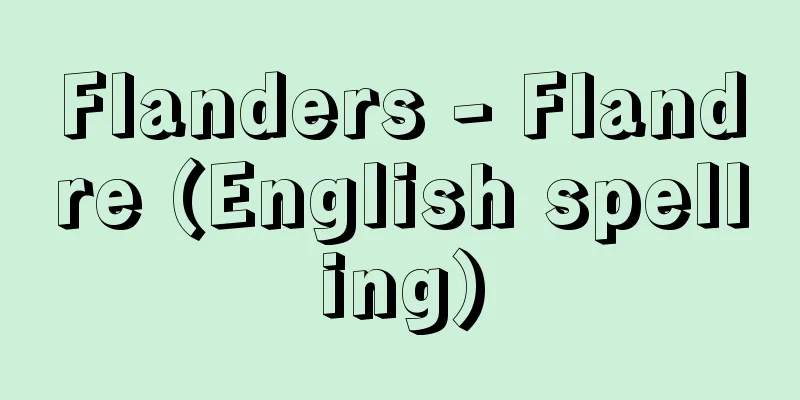Flanders - Flandre (English spelling)

|
The region along the North Sea coast from the lower reaches of the Schelde River (Escaut River) on the Dutch-Belgian border to the Artois hills in northeastern France. "Flanders" is the French name, while the Dutch name is Vlaanderen and the English name is Flanders. [Tamiko Kawakami] GeographyThe region is centered on the current Belgian provinces of East and West Flanders (area 6,126 km2, population 2,482,716, 1997), and includes parts of the Dutch province of Zeeland and the French departments of Nord and Pas-de-Calais. Major cities in the region, such as Aalst, Ghent, Bruges, and Tournai in Belgium, and Lille in France, have been centers of the woolen textile industry since the Middle Ages. Metal and chemical industries have also developed, and Dunkirk in France is a steel-producing city equipped with the latest coastal facilities. Ostend in Belgium and Calais in France are also important transportation hubs with ferry ships and railways connecting them to the UK. The majority of the inhabitants are Flemish and speak a Dutch-based Flemish language. [Tamiko Kawakami] historyFlanders was occupied by the Romans in the 1st century BC and the Franks in the 4th century AD. After it became part of the Frankish Kingdom, it was attached to West Frankish territory in the Treaty of Verdun in 843. In 862, the County of Flanders was formed with Bruges at its center, and it was later divided into the French Kingdom and the Holy Roman Emperor's Kingdom. In the Middle Ages, commerce was revived, and maritime trade was promoted and the wool industry developed significantly, making it an international commercial center. Located halfway between the northwestern European metropolitan area stretching from England to the North Sea coast and the lower Rhine basin, and the northern Italian metropolitan area to the south, Flanders was home to fine medieval cities such as Ypres, Ghent, and Bruges, and continued to harbor a rich urban vitality in industrial development and trade. However, from the 12th century, Flanders came under strong interference from the French king, and Philip IV in particular showed a desire to govern the County of Flanders. However, the citizens of Flanders, backed by their strong economic power, began to fight against their feudal lords, demanding freedom of municipal autonomy. Mutual plundering by French and English merchant fleets led to England halting shipments of wool to Flanders and simultaneously halting the import of Flemish woven cloth. As it became difficult to import wool, Flanders' cities were flooded with unemployed people. Furthermore, the Flemish citizen army was suppressed by the French army at the Battle of Roosbeeck (1382), and the struggle for control of the region eventually paved the way for the Hundred Years' War (1337-1453) between England and France. In 1369, Flanders was incorporated into the Duchy of Burgundy, and this marked a unique era in cultural history, as detailed in cultural historian Huizinga's The Autumn of the Middle Ages (1919). In 1477, Flanders became the territory of the Holy Roman Empire, and then Spain when the Habsburgs inherited the Spanish throne. During the Dutch War of Independence, Flanders, which was part of the Southern Netherlands, remained under Catholic Spain, and has since often been the scene of international conflicts. The Treaty of Westphalia (1648) ceded the northern part of Flanders to the Netherlands and the southern part to France. During the French Revolution and the Napoleonic era, the northern part of Flanders was temporarily part of France, but the Congress of Vienna (1814) made the entire region part of the Netherlands. Eventually, resentment over the preferential treatment given to the north led to Belgium gaining independence as a monarchy in 1830, at which point the provinces of East and West Flanders were born. In the 19th century, with the rise of nationalism and liberalism, Flanders was called the quintessence of Belgium, and was thrown into the whirlpool of language policy known as the Flemish-Walloon problem. In the 20th century, Flemish nationalists became more active, and at one point they allowed an alliance with the Third Reich, which also preached the same nationalism and was seeking to advance into Britain. In 1993, Belgium was reformed into a federal state, and decentralization by language is progressing, with the "Flanders Region" and "Dutch Language Community" in the north and the "Walloon Region" and "French Language Community" in the south. Flanders has a history of being truly congested in politics, economy, religion, and language. [Toru Fujikawa] [References] | | | | | | | | | | | | | |Source: Shogakukan Encyclopedia Nipponica About Encyclopedia Nipponica Information | Legend |
|
オランダ・ベルギー国境のスケルデ川(エスコー川)下流域から、フランス北東部のアルトア丘陵にかけての北海沿岸地域。「フランドル」はフランス語名で、オランダ語名フラーンデレンVlaanderen、英語名フランダースFlanders。 [川上多美子] 地誌現在のベルギーの東西両フランドル州(面積6126平方キロメートル、人口248万2716、1997)を中心とし、オランダのゼーラント州とフランスのノルド県、パ・ド・カレー県の一部が含まれる。ベルギーのアールスト、ヘント、ブリュッヘ、トゥールネー、フランスのリールなどこの地域の主要都市は、中世以来、毛織物工業の中心地。金属・化学工業も発達し、フランスのダンケルクは臨海型の最新設備を備えた鉄鋼業都市となっている。またベルギーのオーステンデとフランスのカレーは、イギリスとの間に連絡船や鉄道が通ずる交通の要地である。住民の大部分はオランダ語系のフラマン語を話すフラマン人系である。 [川上多美子] 歴史フランドル地方は紀元前1世紀にはローマ人が、紀元4世紀にはフランク人が占有するところであった。フランク王国領となった後、843年のベルダン条約で西フランク領に属した。862年にはブリュッヘを中心とするフランドル伯領が形成され、その後フランス国王領と神聖ローマ皇帝領に分割された。中世には商業の復活とともに海上交易の振興と毛織物産業の著しい発展がみられ、国際商業の中心地となる。イングランドから北海沿岸、ライン川下流域に広がる北西ヨーロッパ都市圏と南の北イタリア都市圏の中間地点に位置したフランドルには、イーペル、ヘント、ブリュッヘといった珠玉の中世都市が形成され、産業育成と交易とにおいて豊かな都市生命力を胚胎(はいたい)し続けた。しかし12世紀よりフランドルはフランス国王の強く干渉するところとなり、ことにフィリップ4世はフランドル伯領の統治に意欲を示した。しかしフランドル市民はその強大な経済力を背景に封建領主に対して市政自治の自由を要求して闘争を繰り広げていった。フランスとイングランドの商戦隊の相互略奪に端を発し、イングランドはフランドル向けの羊毛の積出しを停止し、同時にフランドルの織布の輸入を停止した。羊毛の輸入が困難となったことでフランドル諸都市には失業者があふれた。さらにフランドル市民軍がルースベクの戦い(1382)でフランス軍に制圧されるなど、当地域の支配権の争奪はやがて英仏の百年戦争(1337~1453)に道を開いた。 1369年フランドルはブルゴーニュ侯領に編入され、文化史上に異彩を放つ一時代を画したことは文化史家ホイジンガの『中世の秋』(1919)に詳しい。1477年フランドルは神聖ローマ帝国ハプスブルク家の所領に、ついで同家のスペイン王位継承によりスペイン領となる。オランダ独立戦争の際、南ネーデルラントに属するフランドルはカトリック・スペイン領にとどまり、以後しばしば国際紛争の舞台となる。ウェストファリア条約(1648)によりフランドル北部はオランダ、南部はフランスに割譲された。フランス革命、ナポレオン時代には一時北部もフランス領に帰属したが、ウィーン会議(1814)により全域がオランダ領とされた。やがて北部優遇政策への反感から1830年にベルギーが君主国家として独立し、このとき東西フランドル州が誕生した。 19世紀にはナショナリズムとリベラリズムの高揚でフランドルはベルギーの精華と称され、フラマン・ワロン問題という言語政策の渦中に投下された。20世紀に入って活発化するフランドル民族主義者の活動は、一時同じ民族主義を唱え、またイギリス進出をねらうドイツ第三帝国との提携を許した。1993年ベルギーは連邦国家へと刷新され、北部に「フランドル地域」「オランダ語共同体」そして南部に「ワロン地域」「フランス語共同体」が構成されるなど、言語別地方分権化が進められている。フランドルは政治、経済、宗教、言語とまことに輻輳(ふくそう)とした歴史を有している。 [藤川 徹] [参照項目] | | | | | | | | | | | | | |出典 小学館 日本大百科全書(ニッポニカ)日本大百科全書(ニッポニカ)について 情報 | 凡例 |
>>: François Poullain de la Barre
Recommend
Anion - Negative Ion
(Ion) A negatively charged atom or molecule. Negat...
History can be said - Shikaho
A loyal subject in the late Ming Dynasty, China. ...
minimum inhibitory concentration
...This shows the potency of other disinfectants ...
Phalarope (Finniped) - Phalarope
A general term for birds in the family Phalaropodi...
Labor points - Labor points
A scale used by Chinese people's communes and ...
Chromizing
...Due to the nature of the treatment, the coatin...
Multiple pet keeping - Tatou Shiiku
Keeping multiple animals. It is not uncommon to ke...
Otakayama Shrine
This shrine is located in Ogawara-machi, Shibata-g...
Epstein, Jean
Born: March 26, 1897 in Warsaw [Died] April 2, 195...
skelet muscle
…Striated muscles are generally the muscles that ...
Functional Music - Yesterday's Music
... By shining a light on the various musics arou...
Ohi-ki - Ohiki
...About 31 genera and 366 species are distribute...
Aremonite - Aremonko
...More than 30 kinds of elemental minerals are k...
Raymond, M.
...The theories are diverse, and there is current...
Powder forging
Sintered body such as sintered machine parts gener...



![Kusatsu [Hot Springs] - Kusatsu](/upload/images/67d08205f2fe9.webp)





